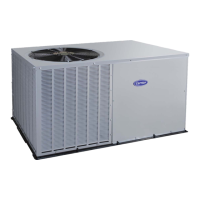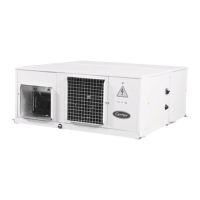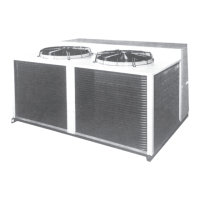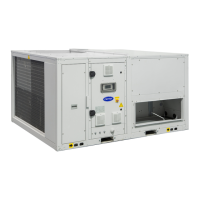: Service Manual
Manufacturer reserves the right to change, at any time, specifications and designs without notice and without obligations.
14
defrost thermostat leads using ohmmeter. Resistance of zero
indicates defrost thermostat is closed and operating properly.
9. Short between the speed-up terminals using a thermostat
screwdriver. This reduces the timing sequence to 1/256 of original
time. (See Table 2.)
10. Unit is now operating in defrost mode. Check between C and W2
using voltmeter. Reading on voltmeter should indicate 24v. This
step ensures defrost relay contacts have closed, energizing
supplemental heat (W2) and reversing valve solenoid (O).
11. Unit should remain in defrost no longer than 10 minutes. Actual
time in defrost depends on how quickly speed-up jumper is
removed. If it takes 2 sec to remove speed-up jumper after unit has
switched to defrost, the unit will switch back to heat mode.
12. After a few minutes, in defrost (cooling) operation, liquid line
should be warm enough to have caused defrost thermostat contacts
to open. Check resistance across defrost thermostat. Ohmmeter
should read infinite resistance, indicating defrost thermostat has
opened at approximately 65°F.
13. Shut off unit power and reconnect fan lead.
14. Remove jumper between DFT and R terminals. Reconnect defrost
thermostat leads. Failure to remove jumper causes unit to switch to
defrost every 30, 60, or 90 minutes and remain in defrost for full 10
minutes.
15. Replace access panel. Restore power to unit.
If defrost thermostat does not check out following above items or
incorrect calibration is suspected, check for defective thermostat as
follows:
1. Follow items 1-5 above.
2. Route sensor or probe using thermocouple temperature measuring
device. Attach to liquid line near defrost thermostat. Insulate for
more accurate reading.
3. Turn on power to outdoor unit.
4. Restart unit in heating.
5. Within a few minutes, liquid line temperature drops within a range
causing defrost thermostat contacts to close. Temperature range is
from 36°F (2.2ºC) to 29°F (-1.7ºC). Notice temperature at which
ohmmeter reading goes from ∞ to zero ohms. Thermostat contacts
close at this point.
6. Short between the speed-up terminals using a small slotted
screwdriver.
7. Unit changes over to defrost within 21 sec (depending on timing
cycle setting). Liquid line temperature rises to range where defrost
thermostat contacts open. Temperature range is from 50°F (10ºC) to
70°F (21.1ºC). Resistance goes from zero to ∞ when contacts are
open.
8. If either opening or closing temperature does not fall within above
ranges or thermostat sticks in 1 position, replace thermostat to
ensure proper defrost operation.
NOTE: With timing cycle set at 90 minutes, unit initiates defrost within
approximately 21 sec. When you hear the reversing valve changing
position, remove screwdriver immediately. Otherwise, control will
terminate normal 10-minute defrost cycle in approximately 2 sec.
Scroll Compressor
A90198
Fig. 17 – Scroll Compressor Refrigerant Flow
The compressors used in these products are specifically designed to
operate with designated refrigerant and cannot be interchanged. The
compressor is an electrical (as well as mechanical) device. Exercise
extreme caution when working near compressors. Power should be shut
off, if possible, for most troubleshooting techniques. Refrigerants
present additional safety hazards.
The scroll compressor pumps refrigerant through the system by the
interaction of a stationary and an orbiting scroll. (See Fig. 17.) The scroll
compressor has no dynamic suction or discharge valves, and it is more
tolerant of stresses caused by debris, liquid slugging, and flooded starts.
The compressor is equipped with an internal pressure relief port. The
pressure relief port is a safety device, designed to protect against
Table 2 – Defrost Control Speed-Up Timing Sequence
PARAMETER
MINIMUM
(MINUTES)
MAXIMUM
(MINUTES)
SPEED-UP
(NOMINAL)
30-minute cycle 27 33 7 sec
50-minute cycle 45 55 12 sec
90-minute cycle 81 99 21 sec
10-minute cycle 9 11 2 sec
CAUTION
!
UNIT DAMAGE HAZARD
Failure to follow this caution may result in equipment damage or
improper operation.
Exercise extreme caution when shorting speed-up pins. If pins are
accidentally shorted to other terminals, damage to the control board
will occur.
CAUTION
!
PERSONAL INJURY HAZARD
Failure to follow this caution may result in personal injury.
Wear safety glasses, protective clothing, and gloves when handling
refrigerant.
Scroll Gas Flow
Compression in the scroll is
created by the interaction of
an orbiting spiral and a
stationary spiral. Gas enters
an outer opening as one of the
spirals orbits.
The open passage is sealed off
as gas is drawn into the spiral.
By the time the gas arrives at
the center port, discharge
pressure has been reached.
Actually, during operation, all
six gas passages are in various
stages of compression at all
times, resulting in nearly con-
tinuous suction and discharge.
As the spiral continues to orbit,
the gas is compressed into an
increasingly smaller pocket.
A90198
1
23
54

